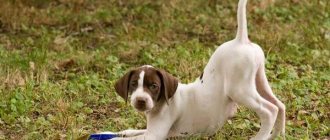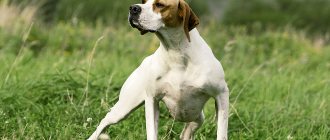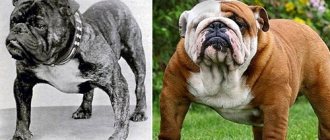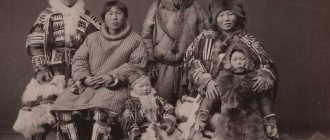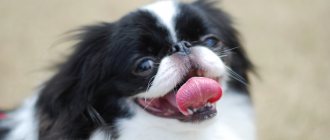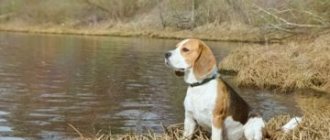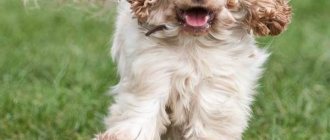Among the majority of hunting dogs, the Pointer can be distinguished separately. These are smooth-haired pointers who combine loyalty, unsurpassed hunting sense, intelligence and kindness.
The owners of the English Pointer breed know that it will show its best side when hunting, and at home it will become a good defender of the hearth from uninvited guests. Being the owner of a Pointer is not enough; you need to be able to find an approach to her and win his trust. Only then will she become a friend and protector.
Origin story
Experts date the birth of pointers to the 16th-17th century. By this time, European hunting enthusiasts had significantly reduced the amount of game, it became more difficult to find it, and the usual hunting breeds were no longer up to the task.
The main original Poiner breeds are
Old Spanish Pointers and Portuguese Bracques. The genes of foxhounds and bulldogs were added to the result of their crossing.
And, as a highlight, to give the exterior an aristocratic appearance, dogs of the new breed were crossed with setters, greyhounds and Old French Braques. The resulting result was called English Pointers. At first, representatives of the new breed kept company with English greyhounds, but after demonstrating their talents, they began to hunt on their own. In the 18th century, the British became interested in hunting birds in flight, and pointers showed their best.
The Pointer is an English dog, but the British themselves sincerely consider it Spanish. The name translates as “pointer”: because of the specific stand that indicates the direction of the bird.
In the mid-19th century, pointers appeared in Russia, as evidenced by mentions in hunting publications. The first of them dates back to 1842. The owners of the hunting breed were nobles who ordered dogs from Britain.
The breed appeared in the USA at the end of the 19th century and immediately gained many fans. Pointers have even supplanted setters, traditional for American hunters.
The English Pointer began to take part in exhibitions as a separate breed in 1877.
The 1917 revolution in Russia also affected Pointers. The Bolsheviks regarded the breed as a symbol of the “bourgeoisie” and purposefully destroyed it. The surviving dogs had to share the fate of ordinary mongrels.
In the early 1920s, A.A. took on the task of restoring the Russian line of pointers. Chumakov. He found purebred pointers and helped them survive both the harsh post-revolutionary times and the Great Patriotic War. The breeder categorically refused to mix the blood of his pets with “purebred British”, considering Soviet cops to be the best.
Among the people who made a huge contribution to the preservation and development of the Pointer breed in Russia, it is worth noting B.A. Kalacheva, I.A. Naydenova, A.V. Platonova, V.P. Rozhdestvensky.
The breed was officially recognized by the Fédération Cynologique Internationale in 1963.
Pit bull terrier - how can a pit bull terrier be cute?
Pitbull Writer is a new breed of Russian selection. This dog, similar to a pit bull in appearance, has a completely different character. Dog handlers have eliminated all temperament defects typical of American pit bull terriers.
The result of their labors was a controlled, kind and intelligent dog with excellent health.
The breed is just gaining popularity, but it has already been recognized by several large cynological communities.
Description and characteristics of the breed
The English Pointer is an ideal pointer, judging by its appearance. The ease of movement and elegance obtained from greyhounds and setters is combined with an aristocratic appearance.
Colors
The English Pointer can be of two types:
- Single color : fawn, red, chocolate (brown), black.
- Two-color : the main color is piebald with an admixture of gray, additional colors are sand, coffee, red, black.
Two-colored pointers are allowed to have specks, but single-colored pointers are not.
Kinds
The hunting dog, popular in Europe, has not been ignored by breeders from different countries, where they have tried to give it features different from the original. Only German breeders were able to achieve recognition of the results of selection . There are three official varieties of the Pointer:
- The English is a classic, large-sized pointer with a smooth coat, graceful body and long legs. It is used in hunting birds and small game - both for tracking and for delivering shot game to the hunter.
- German (shorthaired pointer) - officially registered as a German shorthaired pointer. A large dog with a spotted color. Used in hunting birds and small game. Tolerates cold well and swims well.
- The Pointer Poodle is also the result of the work of German breeders who crossed the English Pointer with the Poodle. He has a heavy build, thick short hair, a beard and mustache. Hardy, smart. It is used in hunting any animal and swims well.
Experts also divide pointers by body type:
- Heavy - from 25 kilograms.
- Lightweight – up to 24.9 kilograms.
Dossier
Adult height: 61 – 69 cm. Weight: 20 – 34 kg. Color: the popular color of the dog breed is black pointer, also plain coffee, red, fawn, there are white spots on the chest, muzzle, throat, and ends of the paws. Black and coffee dogs may have a bronze tint to their cheeks. There are also two-color colors - black-piebald, coffee-piebald, red-piebald, yellow-piebald with large spots and specks on a white background. Coat length: short. Life expectancy: 12 – 17 years. Advantages of the breed: a strong dog, with developed muscles and high intelligence. Difficulty of the breed: dogs need constant walks. Average price: $80 – $200 Classification: large breed, hunting.
English Pointer breed standard
- Height at withers : males - from 63 to 69 centimeters, females - from 61 to 66 centimeters.
- Weight : from 20 to 30 kilograms.
- Head : with a wide skull, prominent occipital protuberance, harmonious. The muzzle is obtuse.
- Eyes : light brown or brown, depending on color, with dark eyelids (except lemon white).
- Ears : thin, medium size, rounded, set high, close to the head.
- Nose : dark-colored, with a depression on the upper part of the bridge of the nose.
- Jaws : With a scissor bite.
- Neck : developed, long, without dewlap, with a slight bend.
- Body : flexible, muscular, but not massive, croup at the same level as the short, arched loin.
- Chest : Dropped to the elbows, broad, strong, with strongly sprung ribs.
- Belly : tucked.
- Limbs : smooth, with strong bones and good muscles. Strong forearms, oblique, sloping shoulder blades, long pasterns. The thighs are voluminous, with strong muscles, the shins are long, the metatarsals are short. The feet are oval, with arched toes and hard pads.
- Tail : medium in length, thick, tapering to the tip. It should not be held above the back or bent upward.
- Coat : Short, hard, straight, of equal length throughout the body.
Disadvantages and disqualifying vices
Any deviation from the physical parameters described in the standard is considered a fault of the English Pointer.
There are only two disqualifying defects:
- Excessive aggression or cowardice.
- Obvious physical or behavioral abnormalities.
Only healthy representatives of the breed, with pronounced characteristic features, take part in breeding.
Character
The English Pointer is, first of all, a hunter. Character traits are determined by the purpose of the breed. Of particular note is the pointer’s willingness to carry out commands not only from one owner, but also from the entire family. Love and devotion also extend to all household members. But in return, the dog will require attention, walks and active games.
The Pointer does not have a developed sense of ownership, so he is a useless watchman. The maximum that can be achieved from him is a lazy “woof” at a stranger who has entered the house. During walks, the dog is reserved towards strangers, but is non-conflicting.
Pointers do not conflict with children, they communicate and play with pleasure , and they steadfastly endure childhood awkwardness, which causes unpleasant sensations.
An English Pointer will never harm a child. Relations with other animals are surprisingly friendly. The English Pointer does not show aggression towards other dogs or cats. On the contrary, he will be happy to make friends with his four-legged neighbors. Of course, if the cat completely relaxes and tries to take on the role of leader, the Pointer will quickly put everything in its place.
The exception is birds. The English Pointer is unable to suppress the hunting instinct when looking at birds - they are the main specialization of the hunter.
Hunting with a pointer
A pointer hunting dog can live in a city apartment, but at the same time it will be impatiently waiting for the next hunting trip.
The pointer is good at hunting birds: quail, partridges, hazel grouse, woodcock, pheasants - his specialization. Representatives of the breed also perform well in hare hunting.
“Englishmen” do not like water, so if you want to use them in waterfowl hunting, you will have to train them separately.
Born hunters, pointers learn commands on the fly and are not afraid of shots. Males are more adventurous than females. During estrus, bitches are not taken out hunting.
The Pointer is a pointer with a well-developed long-range upper sense. He finds the smell of game among other smells, makes a stance, indicating the direction, and then flushes the bird so that the hunter shoots in flight.
The dog is trained to serve game separately; initially, it is not “sharpened” for this.
After a long break, the pointer is not capable of long-term hunting. Its maximum is 3-4 hours a day. During the high season, the dog can work twice a day for 3-4 hours. After three days of hunting, the pointer needs a break of 1-2 days.
Reviews from hunters
Evgeny Grishin. I have had so many different breeds of dogs and English Pointers are the best. They are so funny! Pros: calm, sociable, positive, love to watch TV and sleep 10 hours. Cons: Need a lot of exercise, it is advisable to have your own yard where the dog can walk. If he doesn't have enough activity, he starts hunting shadows!
Ilya Prikhodko. If you're looking for someone to run with in the morning, get a Pointer! A very hardy breed. The ideal companion for adventures. This dog will always keep you in good shape.
Vasily Nikiforov. I always go hunting and take my pointers with me. Males are more resilient, but they are more difficult to train; they strive for leadership and training takes a lot of time and effort. Bitches are much more pliable and can be trained better, but they are weaker and get tired much faster.
We offer you to watch a video dedicated to the best hunting breed - the Pointer. We wish you pleasant viewing!
Training and education
The first months of raising a Pointer puppy are no different from other breeds. Socialization - so that the future hunter gets acquainted with the world around him and learns to react correctly to events. Obedience, rules of behavior, prohibitions. Usually, a puppy that can be trained well becomes an excellent hunter.
Suppression and physical force are unacceptable in raising a Pointer - this is not a working breed, hunters need more freedom. But permissiveness cannot be allowed either.
The first commands that a puppy needs to learn are “Down,” “Forward,” and “No.” You can't do without these commands when hunting. Usually, a lot of effort and time during training is spent on studying them.
Retrieval will also be useful: it helps the dog bring back game.
Before training, it is necessary to practice walking at the foot, obligatory obedience to the owner’s call, following in the indicated direction and the command “Lie down” given at a distance. A treat will be an excellent motivation.
Pros and cons of the breed
The advantages and disadvantages of pointers are due to their narrow specialization as pointers.
Pros:
- Suitable for apartment maintenance.
- Calmness and constancy of mood.
- Friendly to the whole family.
- Excellent relationship with children.
- Lack of aggression.
- Friendly to animals.
- Excellent hunters within their specialization.
- They have good speed and endurance.
- They are smart, obedient, and amenable to training.
- Weakly expressed molting.
Minuses:
- Inability to live on the street.
- Proper education and training is necessary.
- Narrow specialization: bird hunting.
- Inability to resist the hunting instinct when seeing birds.
- They don't like water.
- They do not tolerate low temperatures.
- The need for serious physical activity.
- Stubbornness.
- They do not tolerate loneliness well.
- Incapable of protection.
Personality
Pointers are more popular as working dogs than as pets, although they are ideal for family life. They are friendly, affectionate and obedient dogs that get along well with other dogs and pets if introduced to them early in their lives.
- As a rule, they treat children with love and patience and love to be involved in all family activities.
- They need human contact and are very in tune with living conditions.
- Because of their friendliness, they are not ideal guard dogs, greeting everyone with the same greeting, but they will bark when someone comes to the door.
They are known for their balanced and kind disposition. Because of their thin skin, pointers must be kept in warm, draft-free conditions. They will become destructive and prone to behavioral problems if left alone for long periods of time.
Care and maintenance
The English Pointer will feel great in an apartment or in a house, but keeping it in an enclosure is contraindicated: vulnerability to low temperatures and the need to communicate with people take their toll. When living in an apartment, long, active walks are necessary so that the dog can realize its potential.
The English Pointer is not a lap dog, the breed was bred for hunting. If you don’t want to spend time actively and hunt, you should take a puppy of a different breed. The dog’s warmth-loving nature also dictates the location of the place to sleep and rest: warm, without drafts. During trips, the same conditions are desirable.
Feeding
Many hunters believe that there is no need to feed the dog before hunting - it will make him more active. In fact, this is a misconception. A pointer has nowhere to get energy if he hasn't eaten. Another question is that feeding should be no less than 2 hours before leaving, and should not be plentiful. The pointer is fed thoroughly after a hunt so that the dog realizes that it has earned food.
The number of feedings per day depends on the age of the pointer:
- up to 2 months – 6 times;
- from 2 to 4 months – 5 times;
- from 4 to 5 months – 4 times;
- from 5 to 6 months – 3 times;
- from six months - 2 times.
The main products needed by pointers:
- stringy meat without fat;
- offal;
- sea fish fillet;
- cereals;
- vegetable oil;
- chicken eggs;
- dairy products;
- seasonal vegetables.
From time to time it is necessary to add vitamin and mineral complexes to food. In puppyhood - calcium supplements.
Contraindications in food:
- spicy and highly salted;
- smoked meats and sausages;
- flour and sweet;
- River fish;
- chocolate.
Walk
The need for physical activity is expressed in the number and activity of walks: “The more, the better.” The minimum amount is twice a day for an hour. But this is the bare minimum. Walking on your own in a fenced area will not replace walks with games and training.
The Pointer needs to run a lot without a leash, overcome obstacles, and fetch a ball or plate. It is impossible to bring such happiness to a dog in urban conditions. In the city, a pointer should not be let off a leash: the birds will inevitably attract his attention.
In the cold season, the duration of walks will have to be reduced: the pet cannot tolerate low temperatures. For winter walks, it is better to purchase insulated overalls.
Hygiene
- Combing - twice a week, using a brush or rubberized mitten. Haircut and trimming are not needed. During shedding, twice a year, you will have to deal with the hairs and comb the dog more often.
- Eyes and ears are inspected and treated after each hunt: debris gets into them. A cotton pad and veterinary lotion are used. If it’s not the season, once a week is enough for inspection and cleaning.
- Wool should also be inspected for the presence of ticks and parasites after each trip to nature.
- Nail trimming is a monthly procedure if there are no hunts. During trips, the dog runs around a lot, and the claws wear down on their own.
Mating
In Pointers, puberty begins at 8-10 months, but breeding dogs at this age is not worth it: the body is not yet ready for bearing offspring and giving birth. Early pregnancy is bad for the health of both the bitch and the puppies. Pointers are usually bred at the age of 2 years, or on the third heat.
Before mating, it is necessary to undergo an examination by a veterinarian and treat both dogs for parasites and worms. During pregnancy, these procedures are unacceptable.
Future partners meet while walking. Mating is in the territory of the male. In the process, you may need the help of the owners - to hold the bitch or guide the dog. Control mating is carried out after two days.
From mating to birth, it takes from 56 to 72 days, depending on the number of puppies and the age of the bitch. Pregnancy can be visually determined after a month - the belly becomes rounded, the nipples swell, and the behavior of the expectant mother changes.
Closer to childbirth, it is necessary to limit physical activity, leaving the duration of walking. An expectant mother should not jump and overcome obstacles. There is no need to purchase medical supplies. If everything is in order, they will not be useful. If you need to seek help from a veterinarian, he will bring everything you need with him.
Nutrition
Nutrition depends on the individual characteristics of the pet, such as size, age, activity and metabolism of the body. Doctors recommend two meals a day with two to three cups of high quality food (Eukanuba, ProPlan, Arden Grange, Biomill) or natural food that has a good balance. When eating natural foods, we must not forget about special vitamin and mineral complexes.
Products such as:
- Lean beef, lamb and horse meat
- Chicken and turkey
- Sea or river fish (low-fat)
- Cereals (oatmeal, rice and buckwheat)
- Vegetables (cabbage, potatoes, carrots and beets)
- Eggs
- Cottage cheese
FORBIDDEN! You can’t feed your dogs table scraps, because we often add salt to our food, add various spices, and it can look heavily fried.
Prohibited foods:
- Mayonnaise
- Tubular and other bones
- Pickles
- Sausages, lard and sausages
- Chocolate
- Peanut
- Large amount of butter
Special food is recommended for puppies. During a period of such intensive growth, eating natural food makes it more difficult to calculate the correct dosage of all necessary microelements and vitamins.
For children of different ages, portion sizes and quantities differ:
- Puppies up to 2 months old need to be fed 2 liters of food in 6 feedings.
- From 2 to 3 months – 2.5 liters in 5 servings
- From 4 to 6 months – 3-4 liters required, given in 4 installments
- Starting from six months, puppies need to be fed 2-3 times a day, the total volume of food is 5 liters
Diseases and life expectancy
The English Pointer dog lives quite a long time for its size: from 12 to 14 years. With sufficient activity, proper care and health monitoring, it is not uncommon to overcome the 15-year mark. Pointers' health is excellent. But there is still a predisposition to diseases:
- Arthritis.
- Pelvic dysplasia.
- Age-related eye diseases.
Regular visits to the veterinarian will help detect the disease at an early stage, when it is easier and cheaper to treat. Vaccination is a necessity for a hunting dog.
Health
The Pointer is a breed characterized by excellent health. She is resilient, strong and energetic. But, like any other dog, their representatives have their weak points.
They are susceptible to:
- parasites;
- hip dysplasia;
- diseases of the thyroid gland;
- skin diseases;
- dwarfism;
- problems with joints.
Proper care, nutrition and compliance with all recommendations. Will provide a pointer with a happy long life. The duration of which, by the way, can reach 13 years.
How to choose a puppy and how much a pointer costs
Pointer puppies are cheaper from private owners, but a 100% guarantee of purebred can only be obtained from the breeder. Before purchasing, you should familiarize yourself with the breed’s requirements for activity and lifestyle: this dog is not suitable for everyone.
When choosing, you need to pay attention to the following signs:
- Availability of pedigree and medical documents.
- Appearance and details of parents.
- Compliance of the puppy with breed standards.
- Activity and curiosity.
- Healthy appearance and free movement.
- Clean eyes, ears, nose.
- Excellent appetite.
Depending on the class of the puppy, its cost also changes:
- Pet class , without pedigree, will cost from 10 to 15 thousand rubles.
- Breeding class , a working dog with the right to breed, will cost from 20 to 30 thousand rubles.
- Show class , for participation in exhibitions, starts from 30 thousand rubles.
Interesting Facts
The Pitbull Writer is a very young breed, but we can already tell you something interesting about it:
- Selection work continues to this day. But the writers have stopped adding blood from other breeds to the pit bulls - experts conduct a strict selection among the resulting livestock.
- Modern pit bulls of the writer no longer have anything in common with pit bulls of working (combat) lines. These dogs are absolutely devoid of aggression, so they make excellent companions.
- One day, several dogs got into a fight at an exhibition in Sokolniki. The American pit bull terriers, located in another part of the ring, screamed and rushed away from their owners, wanting to take part in the brawl. The Writer's pit bulls lay calmly in their cages - they did not pay any attention to what was happening.
